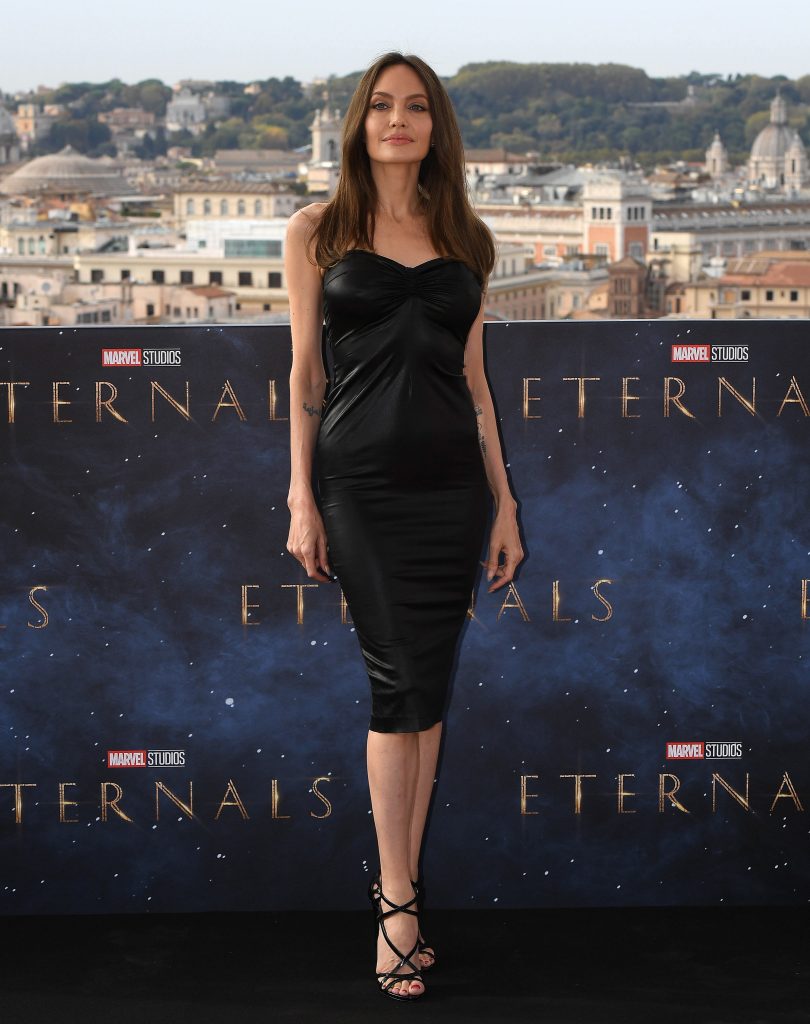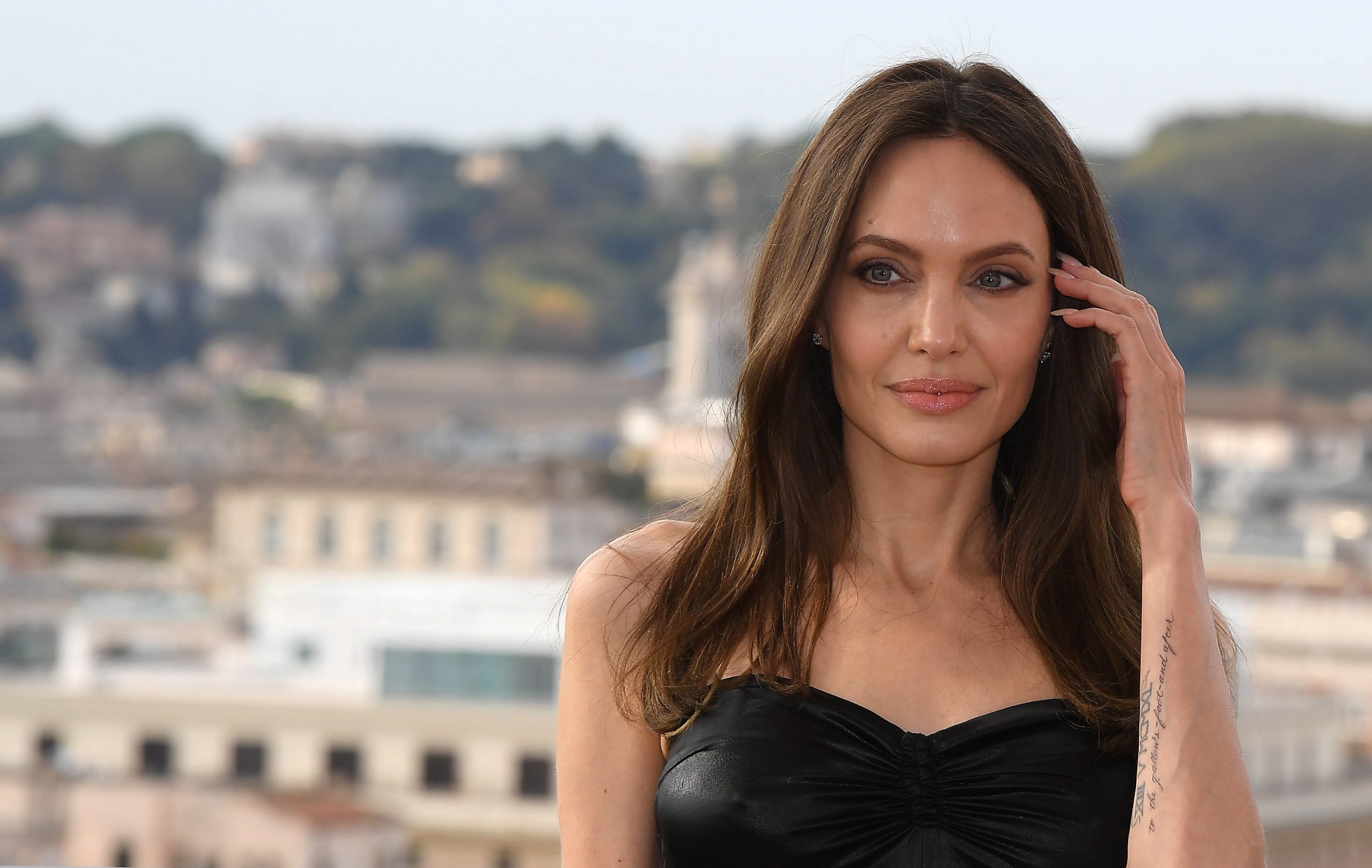ANGELINA JOLIE has found her voice. But first, she says, she lost it.
It was during hours of training to portray the opera singer Maria Callas in her turbulent final days, for an upcoming movie in which Jolie’s voice will be blended with the diva’s famously dramatic renditions of operatic arias.
“I’m a little terrified to do it,” says Jolie, 48, who has never considered herself a singer. “I’m the one who whispers ‘Happy Birthday’ at the party,” she says. During the 2018 filming of Maleficent: Mistress of Evil, she noticed that her voice had changed register since she first played the fairy queen. “My body reacts very strongly to stress,” she says. “My blood sugar goes up and down. I suddenly had Bell’s palsy six months before my divorce.”
It’s been seven years since Jolie filed for divorce from Brad Pitt, the father of her six children. It’s been seven years of negotiation and court filings on everything from custody to the partial sale of their Provençal Château Miraval property and winery. Seven years, she says, of being mostly at home, of thinking, of avoiding work that pulls her away from her family.
“We had to heal,” she says. “There are things we needed to heal from.”
In that time, Jolie has appeared in only five films, nothing compared to the multiple-premieres-per-year pace she had maintained pretty consistently since playing a pixie-cut punk in 1995’s Hackers. The last time she walked a red carpet was to promote the 2021 Marvel movie Eternals, and she has made few public appearances since. Her newest venture, which launched in November, isn’t a celebrity beauty line with ads bearing her face—it’s a sustainable-fashion company where the names of tailors and customers may appear on tags alongside that of the brand, Atelier Jolie. Her next movie is a highbrow international film, not a big-budget blockbuster. Yet she remains overwhelmingly famous, a bona fide global movie star—remember those?—breaking through the vaporous fog of social media. She is indelible despite her best attempts to disappear.

US actress Angelina Jolie poses during a photocall for the movie ‘Eternals’ in Rome, Italy, 25 October 2021. EPA/ETTORE FERRARI
Jolie cannot be conjured up in our Instagram feeds showing us what supplements she takes, the face cream she has developed or what she uses in her hair, as many of her peers now do. Instead, her social-media presence heavily features her humanitarian work and commentary on current events, such as the Israel-Hamas war. She can be periodically found 20 feet tall on-screen, as Maleficent or Lara Croft or Jane Smith, or through the telescope of news coverage in a war-torn nation. When she does materialize in person, say on a Manhattan sidewalk—silent behind dark sunglasses and wrapped up in a coat like some 21st-century cross between Greta Garbo and Elizabeth Taylor—she appears to be actually going somewhere, often with one of her kids in tow. We are merely glimpsing her at the threshold of her real life: Her walk from the car to the hotel door is not in fact the point.
“I wouldn’t be an actress today,” says Jolie. Maybe theater, she caveats, but not Hollywood. “When I was starting out, it wasn’t as much of an expectation to be as public, to share so much.”
She doesn’t read anything about herself, she says. “I’ve just been around so long, and there’s been everything said.”
HAD SHE come of age in the current moment, Jolie might be branded a “nepo baby.” The daughter of actors Jon Voight and Marcheline Bertrand, she got her first job in her father’s film Lookin’ to Get Out, which premiered when she was 7. During her teens, she tried modeling, studied Method acting and appeared in music videos with Meat Loaf and the Lemonheads, often working to supplement her mother’s income, she says. Her parents split when she was just a baby, and Jolie legally dropped her father’s name in 2002. She was in her early 20s when she landed Girl, Interrupted, playing a sociopathic patient at a restrictive 1960s mental institution in the adaptation of Susanna Kaysen’s memoir. The role won Jolie a 2000 Oscar for best supporting actress, but something still felt like it was missing.
“Because I grew up around Hollywood, I was never very impressed with it,” says Jolie. “I never bought into it as significant or important.”
Early fame felt crushing. She was depressed and, at points, suicidal, she says. The height of her career arrived as her mother was dying of cancer. Bertrand had taught her to throw on a backpack and head off on adventures, Jolie says, and this became a coping mechanism. “I wanted to escape,” she says.
Jolie made field visits to refugee camps in Cambodia, Tanzania, Sierra Leone and Pakistan. She officially started her work with the United Nations the year after she won her Oscar. In 2002, she adopted her oldest son, Maddox, from an orphanage in Cambodia, a country she first visited when filming Lara Croft: Tomb Raider.
“There’s a reason people who have been through hardship are also much more honest and much more connected, and I am more relaxed with them,” says Jolie. She reflexively answers an inevitable question: “Why do I like spending time with people who’ve survived and are refugees? They’ve confronted so much in life that it brings forward not just strength, but humanity.”
Meanwhile, in L.A., “I don’t really have…a social life,” says Jolie. She says she isn’t currently dating.
“I realized my closest friends are refugees,” she says. “Maybe four out of six of the women that I am close to are from war and conflict.”
Her children have grown up since their days as tabloid fixations, with the oldest out of college and the youngest in high school. Their voices are ones she trusts. “They are the closest people to me and my life, and they’re my close friends,” she says. “We’re seven very different people, which is our strength.”
After so many years of fame, she has resigned herself to some elements of its Faustian bargain. The constant gaze of paparazzi means she may not accompany her kids on trips or activities. “You kind of step out when there’s times you would have liked to have been there,” she says.
The public—meaning, in her case, essentially the entire outside world—has given her a career, she says. “They’ve also chosen how they want you.
“Since I was young, people liked the part of me that’s pretty tough and maybe a bit wild—that’s the part that I think people enjoy,” she says. “I’m not the one [who] you want to hear about my pain or my sadness. You know, that’s not entertaining.”
Jolie plans to eventually leave L.A. “It’s part of what happened after my divorce. I lost the ability to live and travel as freely. I will move when I can,” she says, and spend more time at her home in Cambodia.
“I grew up in quite a shallow place,” she says. “Of all the places in the world, Hollywood is not a healthy place. So you seek authenticity.”
THIS YEAR, after two decades of working with the U.N., Jolie has moved on to partner with refugees in a more direct capacity. In her final speeches for the U.N., she says she has been frustrated with the lack of progress in addressing the root causes of the ongoing global refugee crisis. Closer to home, she remains involved in a legal dispute with Pitt over the rosé-producing French wine estate they once jointly owned, Château Miraval.

Actor Angelina Jolie, UNHCR Special Envoy, speaks during a news conference at the Al Zaatri refugee camp, in the Jordanian city of Mafraq, near the border with Syria, January 28, 2018. REUTERS/Muhammad Hamed
Meanwhile, Jolie is at a career crossroads. The strata under her are shifting: Professionally, she once toggled between major tentpole film franchises, which could guarantee huge box-office returns, and smaller indie dramas. It’s a framework that no longer holds the same certainty: Eternals may have garnered $402 million worldwide, but it was still generally regarded as a disappointment. Jolie may profess to be less interested in Hollywood, but the world is also less interested in Hollywood. Movie stars are becoming an endangered species, leaving the industry grappling with a void. One of this fall’s few theatrical bright spots was not a big-budget, star-studded movie at all, but essentially a highly polished video of Taylor Swift.
In this new world, Jolie has been able to take on more varied projects. She’s shooting Maria as Callas, her first role in two years, which started production in Paris in October. (The film obtained a SAG-AFTRA interim agreement allowing it to proceed.) She recently finished her fifth directorial effort, Without Blood, a wartime film starring Salma Hayek Pinault and Demián Bichir that she wrote, based on a book by Alessandro Baricco.
She is signed on to act in several more, including a third Maleficent. Last year, she struck an international film and TV deal with British-based company Fremantle. And she’s also producing a Broadway show, The Outsiders, which opens in April; she discovered this musical version based on the book by S.E. Hinton at the La Jolla Playhouse in San Diego thanks to her youngest daughter, Vivienne, who is now working as an assistant on the show.
“I’m very hyphenated,” says Jolie.
This month she adds yet another hyphen, when she opens her first stand-alone fashion venture: Atelier Jolie, an experimental foray into tackling fashion’s vast sustainability, production and labor issues. To say it’s a sustainable clothing line designed in part by Jolie and sold at her store is too simple.
“If it’s easily explained, it’s probably not going to be as fulfilling as it could be,” she says. “In my life, I’ve never been understood right away.”
She also seems to have an almost compulsive need to work. “I can’t stop,” she says. “I always think there’s like a fight coming.”
Jolie says people around her laughed when she told them about her new venture: “You, in fashion? No.”
“I’ve never been to a fashion show or Met Ball my entire life,” says Jolie. She has often worked with Versace on custom dresses for major red-carpet moments. Instead of closely following fashion trends, she says, “I love individuality and I love freedom.”
So in an inversion of many startups, which launch without a physical retail presence, Jolie is opening a brick-and-mortar space in the heart of New York City’s NoHo, in the former studio and home of Jean-Michel Basquiat. It was most recently a Japanese restaurant. The facade is a constantly changing tapestry of graffiti by street artists leaving tributes to Basquiat, including a two-story-tall crown. Inside, customers will find clothes created by Jolie, her collaborators other sustainability-minded brands. There are take-home sewing patterns and by-appointment tailors and designers to customize garments. Customers can bring in pieces they already own for adjustments, or create their own from scratch using deadstock fabric.
There will also be a cafe, Eat Offbeat, run by refugee and immigrant chefs. In the cafe space, people can create or buy patches (starting at $15) to sew onto garments. Jolie is planning to host educational events focused on techniques such as silk-screening, studding and embroidery. In an upstairs studio-like fitting room, clients who want a more couture experience can take private appointments—for, say, designing a wedding dress. A gallery will include rotating works of art. Atelier Jolie recently launched a capsule collection with Chloé. She hopes to host salons on subjects including sustainability and art.
“I’ll probably lose money, maybe even for a while,” says Jolie. The 6,600-square-foot space was advertised at $60,000 per month for a minimum 10-year lease; a representative for the brand declined to share the terms of the lease but said Jolie is paying less and isn’t committed to 10 years. “If I can eventually put into practice some things that I think are improvements and I just break even, that’s a huge victory.”
She is looking to answer questions that many others in fashion have explored with limited success. “What would be an ethical business? We are trying to reverse-engineer it a little bit,” says Jolie, who began by consulting human rights lawyers before tackling sustainability and circular design. She and her team established a committee to guide the brand’s approach to sourcing and production.
“I don’t know the answers,” says Jolie. “Can we avoid doing real damage—not only to the earth, but the garment workers? … Is it possible that I could go somewhere and enjoy making clothes, enjoy wearing clothes and not hurt anybody? And actually maybe treat people well?”
Day-to-day, Jolie admits to having a busy-mom uniform that’s more practical than playful: throwing on a coat with her lounge clothes to look elegant while running errands. “My daughter jokes that I wear too many trench coats,” she says, laughing. “It’s just like a hiding thing.”
Jolie often relies on Saint Laurent and Celine for a battery of shift dresses, slacks, sweaters and tote bags—chosen, she says, to project an image of unflappable, ladylike safety to her children. For nearly 22 years, she says, “I’ve been a mom, and I’ve fully absorbed that into who I am.”
She says she’s more comfortable than ever in her body. “It’s like I see my scars and my things, and I feel like I’ve lived. And I’m having these big experiences, and I have this map of this complex body that’s changed over time.
“You and I both know that a woman with a full life is very sexy.”



